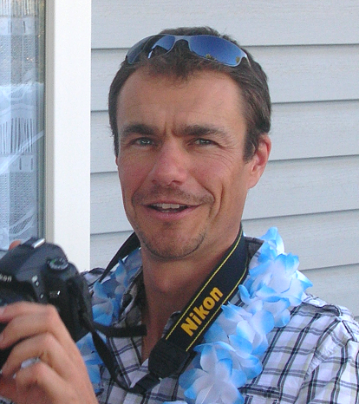Franck CATTANEO, Ph.D.
Professor HES
franck.cattaneo@hesge.ch
+41 (0)22 546 68 46
‘Ecology and Engineering of Aquatic Systems’ research group leader

synopsis
Fish ecologist, I completed my PhD in 2002 (University of Toulouse and Cemagref Lyon, France). It aimed at better understanding the relationships between flow regimes and fish assemblages across a variety of spatial and temporal scales. After several post-doctoral positions in New-Zealand and France, I officiated for nearly two years in a private office in environment. Professor at the University of Applied Sciences and Arts Western Switzerland since 2007, I’m particularly involved in projects in the field of eco-hydrology and fish resource conservation and management. I’m concerned with understanding how organisms are constrained by environmental variability in a broad sense and biotic processes, from biological scales ranging from the individual to the community. Of particular interest are factors and processes subject to anthropogenic alterations, for which management measures or restoration actions constitute applied outcomes. Overall, my research is carried out in close collaboration with both Swiss and French stakeholders, including government offices, energy industrials, public research organizations, local and regional water managers, or private offices.
main research
An important part of my current research activities deals with the impacts of damming on riverine ecosystems, and how to mitigate them. Major goals include 1) quantifying the crossing over weirs and dams for several species as well as the consequences of river fragmentation for their population dynamics and long-term conservation, and 2) help defining more sustainable flow and sediment management strategies, including environmental flows and sediment releases from dams. On this topic, I led several national projects, as well as of the EU Interreg IVa ‘ESPACE Arve & Rhône’ project (www.espace-arve-et-rhone.com).
Besides, I’m also interested in fish resource management, especially for Salmonids. My work aims at 1) puzzling out the factors (biotic and abiotic) and processes that govern populations’ structure and dynamics in space and time; 2) achieving a better understanding of the fish-habitat relationships in a dynamic point of view, which is crucial in the era of river restoration and biodiversity conservation; 3) evaluating impacts of management practices (such as restocking) on recipient populations.
Some key research focuses are listed below:
- Influences of natural and altered flow regimes on populations and communities
- Hydrological restoration of altered flow regimes (‘environmental flows’)
- Impacts and mitigation of sediment management practices in running waters
- Ecological connectivity, dispersal, quantification of fish crossing over dams
- Habitat uses and preferences across scales, management-oriented environmental classifications
- Conservation and management of fish resources: assessment of restocking impacts, definition of management units
Research issues are investigated both by in situ and experimental (lab) approaches, and are explored by means of a variety of methods within the fields of ecology, genetics, or eco-physiology. In recent years, the team developed skills in telemetry methods, including RFID (pit-tagging), radiotelemetry, and hydroacoustics.
KEYWORDS: Ecohydrology, conservation, dams, flow, sediment, population dynamics, telemetry
external responsabilities & affiliations
- Member of the Scientific Board of French Water Agency ‘Rhône-Méditerranée-Corse basin’
- Member of the Scientific Board of ‘Commission internationale pour la protection des eaux du Léman (CIPEL)’ (International commission for the protection of Lake Geneva waters)
- Member of ‘Commission de la pêche’ (Fisheries Commission) of Geneva State
teaching & supervision
Course of:
- Ecology – Hepia Gestion de la Nature (GN), Agronomie & Œnologie (Changins), 1st semester
- Population ecology - Hepia GN, 2nd semester
- Methods of studying aquatic fauna - Hepia GN, 4th semester
- Applied statistics - Hepia GN, 4th semester
- Management and monitoring of aquatic species - Hepia GN, 5th semester
- Orientation ‘Natural Resource Management’, Master Life Sciences HES-SO
Supervision of:
- Post-doctorate researchers (B. Bergerot, D. Grimardias, R. Santos)
- Doctorate student (Alexandre Richard, Ph.D. defended in Apr. 2014)
- Several M.Sc. students
- Bachelor students
collaborations
cf. Projects
5 selected publications
Grimardias, D., Guillard, J. and Cattanéo F. Drawdown flushing of a hydroelectric reservoir on the Rhône River: impacts on the fish community and implications for sediment management (en révision)
Bergerot, B. and Cattanéo, F. (in press). Hydrological drivers of brown trout population dynamics in France. Ecohydrology.
Cattanéo, F., Grimardias, D., Carayon, M., Bardonnet, A. and Persat, H. 2014. A multidimensional typology of riverbank habitats explains the distribution of European grayling (Thymallus thymallus L.) fry in a temperate river. Ecology of Freshwater Fish, 23: 527-543.
Lamouroux, N. and Cattanéo, F. 2006. Fish assemblages and stream hydraulics: consistent relations across spatial scales and regions. River Research and Applications, 22: 727-737.
Cattanéo, F., Lamouroux, N., Breil, P. and Capra, H. 2002. The influence of hydrological and biotic processes on brown trout population dynamics. Canadian Journal of Fisheries and Aquatic Sciences, 59: 12-22.
